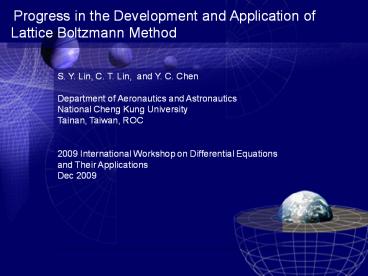Progress in the Development and Application of - PowerPoint PPT Presentation
1 / 33
Title:
Progress in the Development and Application of
Description:
Progress in the Development and Application of Lattice Boltzmann Method S. Y. Lin, C. T. Lin, and Y. C. Chen Department of Aeronautics and Astronautics – PowerPoint PPT presentation
Number of Views:45
Avg rating:3.0/5.0
Title: Progress in the Development and Application of
1
Progress in the Development and Application
of Lattice Boltzmann Method
S. Y. Lin, C. T. Lin, and Y. C. Chen Department
of Aeronautics and Astronautics National Cheng
Kung University Tainan, Taiwan, ROC 2009
International Workshop on Differential Equations
and Their Applications Dec 2009
2
Outline
- 1. Objective
- 2. LBM Mathematics and Physics
- 3. LBM Computation
- 3.1 Pressure-Based LBM
- 3.2 Immersed Boundary (IB) Method
- 3.3 Compressibility Effect
- 3.4 Force Evaluation
- 4. Numerical Tests
- 5. Fluid-Particles Interaction Problems
- 6. Conclusions
3
1. Objective
- Develop an Incompressible Flow Solver to Study
Debris Flows. (Goal)
- Combine LBM and IB Method to Simulate
Fluid-Particle Interaction Problems. (First Step) - Introduce a Direct-Forcing Method for IB Method.
- Sedimentation of a Large Number Spherical
Particles in an Enclosure.
- Investigate Solid-fluid Mixture Flows. (Second
Step, Two-Phase Flow)
4
1. Objective
Solid-fluid Mixture Flows
Liquefaction
Sedimentation
5
2. LBM Mathematics and Physics
Incompressible Navier-Stokes equations PDE
LBM D3Q15 LBM Algebra Equation for density
distribution function
6
2.1 LBM Mathematics and Physics
- Applications
- Incompressible Navier-Stokes Solver.
- Two-Phase flow
- Micro Flow
Kn Knudsen
7
2.2 LBM Mathematics and Physics
Boltzmann Equation BGK Collision
Maxwell-Boltzmann Equilibrium Distribution
First-order finite difference scheme in time
First-order upwind scheme for convective term
8
2.3 LBM Mathematics and Physics
LBM to Navier-Stokes Equation Chapman Enskog
Expansion
9
2.4 LBM Mathematics and Physics
Deriving of Equilibrium Particle Distribution
Function
10
2.5 LBM Mathematics and Physics
Density-Based LBM
Pressure-Based LBM
11
2. Boltzmann Distribution Function
Question Uniqueness? In Engineering No
question In Physics Yes, I need to think about
it. In Mathematics O! Its very important.
In general (No Physical sense), How can I
solve?
12
3. LBM Computation
- Pressure-Based LBM
- Immersed Boundary Method
- Direct-Forcing Method
- 3. Compressibility Effect
13
3.1 Pressure-Based LBM
Advantages 1) Incompressible Flow 2) Inlet
Boundary Condition Velocity Given 3) Outlet
Boundary Condition Pressure Given
14
3.2 Immersed Boundary Method (IB)
The total force, f, on a particle 1.
external forces gravity force 2.
internal forces collision forces between
particles and walls, drag/lift forces in the
fluid-particles interaction motion. The
drag/lift forces are obtained by the immersed
boundary method.
15
3.2.1 Immersed Boundary Method (IB)
Direct-Forcing Method
Step1 Define Volume fraction function to
identify the body cells
1, in the particle cells 0, in the fluid cells
Step2 LBM to obtain
Step3 Direct-forcing to update
Particle velocity
16
3.3 Compressibility Effect
- The sound speed in LBM is
- Non-dimensional Velocity lt
- In non-dimensional unit
0.1
larger
17
3.4 Force Evaluation
Ease for moving particle and complicated geometry
18
4. Test Problems
- Flow over a fixed sphere
- Sedimentation of one spherical particle in a
viscous fluid - Sedimentation of two spherical particles in a
viscous fluid
19
4.1 Flow over a fixed sphere(1)
- ReUD/n
- CD
- D812 grids
- Grids system(10D,20D,10D)
19
20
4.1 Flow over a fixed sphere(2)
Table 1.
20
21
4.1 Flow over a fixed sphere(3)
Re50
Re100
Re150
Re200
22
4.2 Sedimentation of one spherical
particle in a viscous fluid(1)
1. Dimensions of the enclosure is 10-cm long,
10-cm wide and 16-cm high. The particle commences
its motion at a height H 12 cm from the
bottom. 2. Particle has density 1120 kg/m3 and
radius 1.5 cm. 3. Computational Grid 8080128
grid points and the particle is outlined by 12
grid points.
Table 2 The fluid properties used
23
4.2 Sedimentation of one spherical particle
in a viscous fluid(2)
Fig 1 Comparisons between trajectories by
simulations and measurements.
Fig 2 Comparisons of the measured and simulated
settling velocities.
24
4.3 Sedimentation of two circular particles in a
viscous fluid(1)
- The enclosure is 10 cm long, 4 cm wide, and 40 cm
high. - The fluid density is 960 and the dynamic
viscosity of the fluid is 0.113. - Each particle density is 1120 and diameter 2 cm.
- A uniform grid of 5020200 is used and the
diameter of spherical particle is 10 grid points.
25
4.3 Sedimentation of two circular particles in a
viscous fluid(2)
P2
P2
P1
P2
Fig. 3 Flow velocity fields in the X-Z plane
along Y2 cm at t 0, 0.51, 1.02, 1.53, 2.04,
2.55, 3.06, 3.57 sec. drafting-kissing-tumbling
process
26
4.3 Sedimentation of two spherical particles in a
viscous fluid(3)
Fig 4 The histories of two particles (a)
x-position and (b) z-position.
27
4.3 Sedimentation of two spherical particles in a
viscous fluid(4)
Fig 5 The velocities of two particles (a)
u-velocity and (b) w-velocity.
28
5. Sedimentation of a large number spherical
particles in an enclosure
Fig 6 1260 particles in an enclosure
29
5. Sedimentation of a large number spherical
particles
Rayleigh-Taylor
30
5. Sedimentation of a large number spherical
particles
31
5. Sedimentation of a large number circular
particles
32
6. Conclusions
1. LBM Navier-Stokes equation, compressibility
effect, bound conditions. 2. The direct-forcing
method is very efficient and stable forcing
method for the immersed boundary method. 3.
Force evaluation method is efficient and
accurate. 4. Sedimentation of a large number
circular particles in an enclosure is simulated.
This shows that the IB-LBM can simulate
complicated fluid-particles interaction problems.
33
- THANKS































